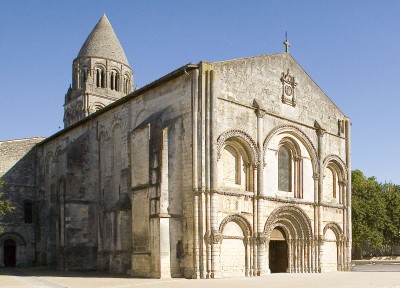To meet all these challenges, in collaboration with the city of Saintes, a cross-sectoral consortium of partners based in the Nouvelle Aquitaine region and representing the sectors of culture (Saintes’ Abbaye aux Dames, Saint Jean d’Angely’s Abbaye Royale de Saint Jean, the Abbaye de Fontevraud), heritage (Saintonge’s Heritage Workshop), social support (the Social Centre of Belle Rive) and tourism (the Tourist Office Mission of Nouvelle Aquitaine, the tourist offices of Saintes, Saintonge Dorée, Pays Cadillaçais, Gartempe-Saint Pardoux, Saint Jean Pied de Port and Saint Etienne de Baigorry, Vézère Monédières, Limoges, Ussel-Meymac Haute-Corrèze, Grand Dax, Entre-Deux-Mers and Lacq Coeur de Béarn) was formed to identify best practices in heritage interpretation and audience development at a European level and thus build the skills of their teams.
As part of the ERASMUS+ project “Heritage Interpretation & Innovative Practices” (HIIP) [2015-1-FR01-KA104-014681], 63 participants, cultural heritage mediators in their area, were trained in new, more sensory, creative and interactive practices with adult audiences, on the occasion of the 114 trips made in 11 countries of the European Union (Belgium, Croatia, Czech Republic, Denmark, Germany, Greece, Holland, Hungary, Italy, Spain, United Kingdom).
During the project’s two-year duration, 13 shadow programmes and seven formal/training courses were conducted. The cross-sectoral nature of our consortium enabled all participants to express themselves and contribute their own professional views to enrich the global scope of our analysis.
The HIIP project enabled the participating organisations and individuals to experiment and adopt a more appropriate approach for the profiles of their adult audiences. It also made it possible for the organisers to join them in co-constructing the interpretation of the cultural heritage in their area, calling for more creativity, interaction and discussion.
These mobility initiatives will make it possible to identify best practices for the promotion of cultural heritage and the involvement of local populations and enrich our proposal for a “New Discovery and Interpretation Itinerary”.
Since June 2016, the following foreign organisations welcomed members of the consortium:
- The Venetian District for Innovation and Research (DVRI) – Italy
- The city of Dubrovnik – Croatia
- The city of Skanderborg – Denmark
- The European Federation of National Youth Orchestras (EFNYO) – Austria
- Culture Action Europe (CAE) – Belgium
- The Château Karolyi de Fehervarcsurgo Heritage Site for Culture – Hungary
- The LandKunstLeben, Steinhöfel/Buchholz Heritage Site for Culture – Germany
- Interpret Europe – Germany
- Fondazione Palazzetto Bru-Zane – French romantic music centre – Italy
- Institut Français d’Ecosse – United Kingdom
- E.P. Europrojects Granada S.L. – Spain
- Patrimoine à Roulettes asbl – Belgium
- Plzen 2015, obecne prospesna spolecnost – Czech Republic
- Réseau de Musiciens Intervenants en Ateliers – Belgium
- Stichting Amsterdam Museum – Holland
- The National Trust for Scotland – United Kingdom
- Union Association pour la Participation et l’Action Régionale – Centre Méditerranéen de l’Environnement – France.
This project was financed with the support of the European Commission.
The author has sole responsibility for the content of this publication. The Commission is not responsible for the way its content may be used.
http://ec.europa.eu/programmes/erasmus-plus/index_en.htm
http://www.agence-erasmus.fr/index.php



